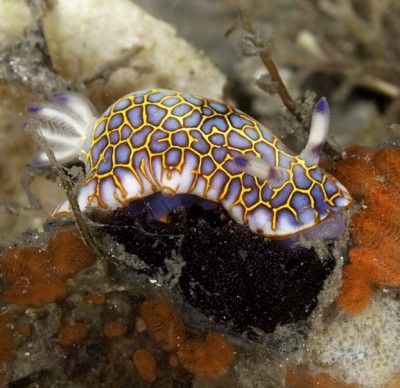
Chromodoris sp. 17
Order: NUDIBRANCHIA
Suborder: DORIDINA
Superfamily: EUDORIDOIDEA
Family: Chromodorididae
DISTRIBUTION
Caribbean
PHOTO
Locality: Lake Worth Lagoon, 15 feet, Florida, USA, Atlantic Ocean, 14 June 2009, Intracoastal, tidal. Length: Approx 1 inch [2.5 cm]. Photographer: Linda Ianniello.
This animal has been identified as Chromodoris neona in the book Caribbean sea slugs (A. Valdes, J. Hamann, D.W.Behrens & A. DuPont, 2006). However, it is differs in many external features from the original description by Ernst Marcus of C. neona. The differences are discussed in detail on the C. neona Fact Sheet and in the following messages: #22560, #22600.
I am calling this species Chromodoris sp. 17. It has a blue background colour, with a broad white band around the mantle edge. The mantle is covered with a yellow reticulate pattern, the yellow line being edged with reddish or dark purple. The edge of the mantle also has a similarly coloured yellow or yellow-brown border. In photos in Valdes et. al. the tip of the posterior foot is dark purple and there is a broad white median line. The most distinctive feature differentiating this species from C. binza, C. clenchi and C. neona, are the white gills and rhinophores with purple tips. In the other species the red or purple colouration on the gills and rhinophores consists of coloured lines along the edges, and sometimes also a diffuse spreading of the colour over all of these organs. In Chromodoris sp. 17 the rhinophore stalk can also be purple, as in Linda Ianiello's photo. Traces of purple can also be seen in the photos in Valdes et. al.
Authorship detailsRudman, W.B., 2009 (August 18) Chromodoris sp. 17 [In] Sea Slug Forum. Australian Museum, Sydney. Available from http://www.seaslugforum.net/find/chrosp17
Related messages
Re: Chromodoris from North Carolina
December 21, 2009
From: Roger Skillman
Concerning message #22985:
Thanks Dr. Rudman,
I'll be at Radio Island during 2010 and will look for more of these and collect better pics.
Roger
rogerskillman@anderson5.net
Skillman, R.L., 2009 (Dec 21) Re: Chromodoris from North Carolina. [Message in] Sea Slug Forum. Australian Museum, Sydney. Available from http://www.seaslugforum.net/find/22994Dear Roger,
I look forward to any pics you succeed in getting. In fact the opisthobranchs of the east coast of Nth America iare not well documented so photos of any species would be of interest
Best wishes,
Bill Rudman
Chromodoris from North Carolina
December 16, 2009
From: Roger Skillman
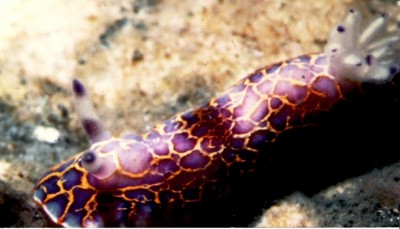
Could someone please identify this for me? I took this picture in 1988. Sorry for the picture quality.
Locality: Beaufort, 8 m, NC, USA, Atlantic Ocean, July 1988, Radio Island Rock Jetty. Length: <5 cm. Photographer: Roger Skillman.
Roger Skillman
rogerskillman@anderson5.net
Skillman, R.L., 2009 (Dec 16) Chromodoris from North Carolina. [Message in] Sea Slug Forum. Australian Museum, Sydney. Available from http://www.seaslugforum.net/find/22985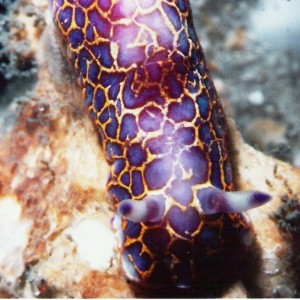
Dear Roger,
This has recently been identified as Chromodoris neona, but as I have discussed elsewhere on the Forum, I think this is an unnamed species which I am calling Chromodoris sp. 17. Have a look at the Fact Sheet for further information.
I suspect this is quite a range extension for the species which has previously not been reported further north than Florida
Best wishes,
Bill Rudman
Re: Feeding observations on Chromodoris neona?
August 19, 2009
From: Linda Ianniello
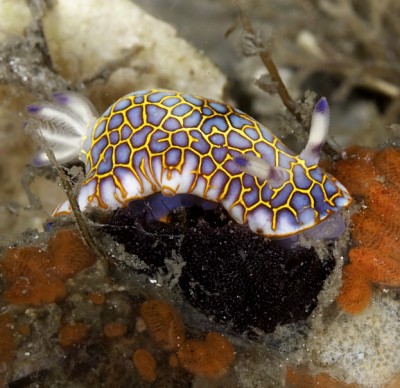
Concerning message #22482:
Hi, Dr. Bill.
To add to the Caribbean Chromodoris story, here are two images. The single animal matches the C. neona in the Caribbean sea slugs book. However, it is quite different than the C. neona on the forum. The other image shows what I think is a C. binza and two C. neona, all feeding on the same dark purple sponge.
Locality: Lake Worth Lagoon, 15 feet, Florida, USA, Atlantic Ocean, 14 June 2009, Intracoastal, tidal. Length: .5 inch and 1 inch. Photographer: Linda Ianniello.
I don't know if this will help clarify anything, or add more confusion!
Regards,
Linda I.
lindai1@bellsouth.net

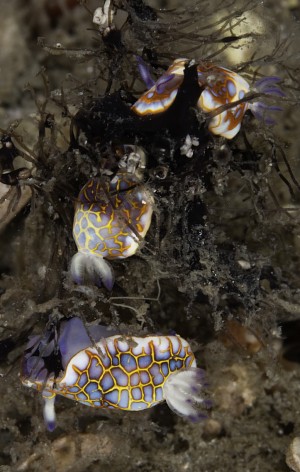
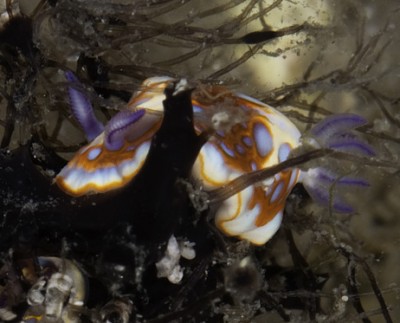
Dear Linda,
More observations are always valuable. It is true that when you only have a few observations it is quite easy to build up a simple story. While it can be momentarily disappointing when such stories fall apart, more information helps to build a richer more complex story, which in the end is much more satisfying.
The animal identified as C. neona in the Caribbean Sea Slugs book is not what Marcus described as C. neona. Marcus specifically described the gills and rhinophores as red-violet. From that I feel that Guido Villani's photo on the Fact Sheet fits Marcus's description almost perfectly. He would have described them as white with purple tips if it was the species in your photos and the Caribbean Sea Slugs book. The only tip Marcus mentions is the posterior tip of the foot which he describes as red violet - which again fits Guido Villani's photo. I guess this is an unnamed species as I can't find any described species with white gills and rhinophores with purple tips. I have posted a separate message with more on Marcus's description of C. neona [see message #22600]. I will call this species Chromodoris sp. 17 on the Forum.
Aside from the C. neona question, the more photos I see the more I am convinced that C. binza is just a colour form of C. clenchi.
I am sure the sponge is a species of Chelonaplysilla. It is interesting to see a group of similarly coloured Caribbean species all eating the same species of sponge. As I have suggested is the case with similarly coloured species in the Pacific eating the same sponge, this is almost certainly associated with the 'teaching' potential predators that certain colour patterns are distasteful.
Best wishes,
Bill Rudman
